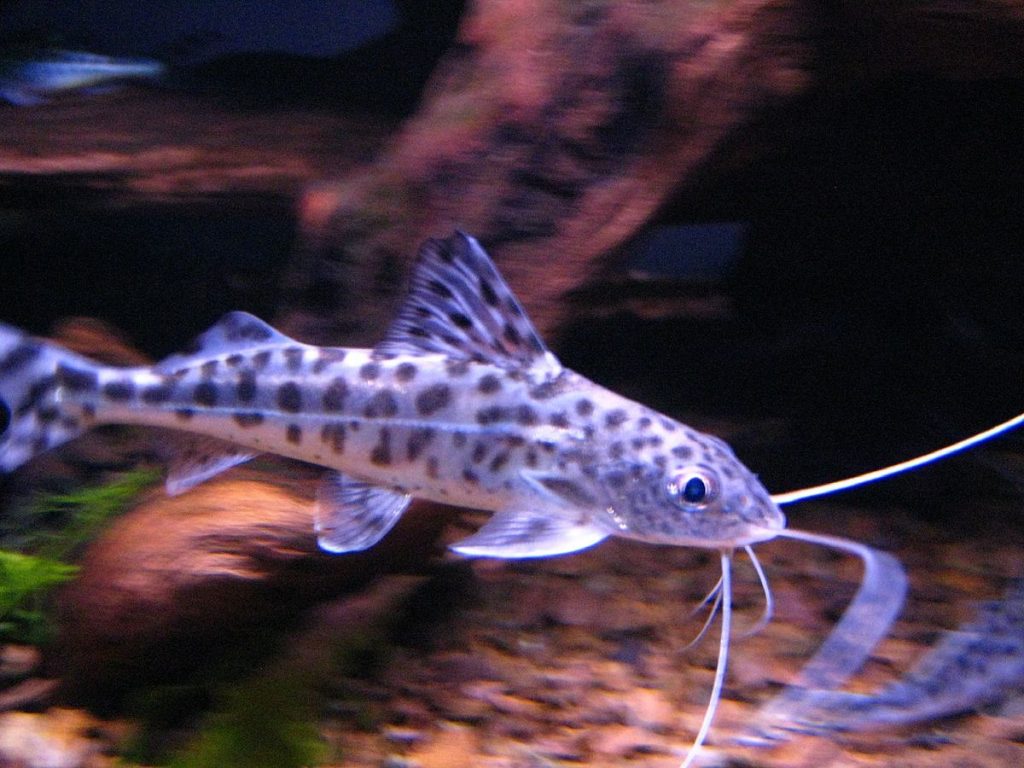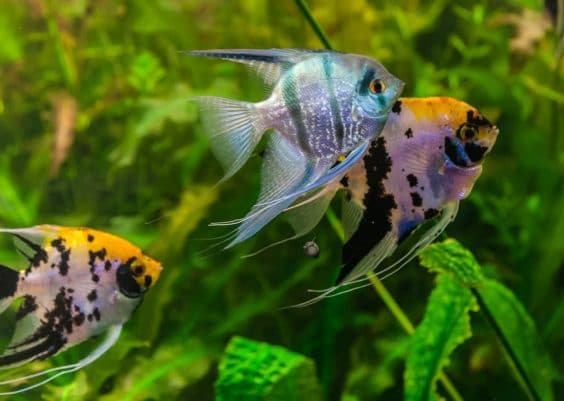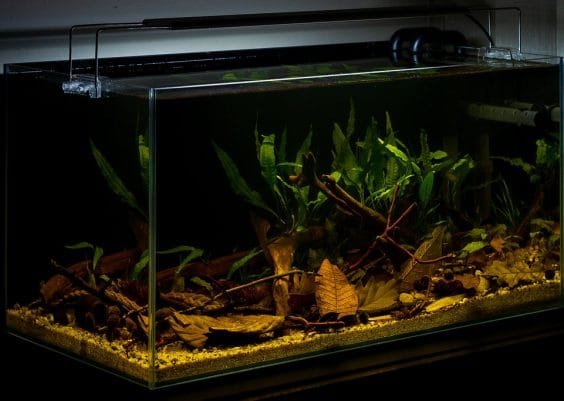Contents
Pictus Catfish is considered one of the most wonderful catfish varieties available on the market, so it’s not a surprise that people get tongue-tied the first time they see the fish.
In spite of their preference for caves and hiding spots, their appearance in the aquarium makes for a stunning treat that many aquarists love.
Although this type of fish is not recommended for a novice because of their large gallon requirements and community stocking limitations, they are otherwise peaceful and hardy creatures.
This catfish might not like to be overly active during the daytime, but their hectic nightlife and voracious feeding schedule more than compensate for this.
They are fun to watch due to their colors and the complicated social lives they have and the natural behaviors they express in aquariums that simulate their South American habitat.
Pictus Catfish Overview
Coming from the Pimelodidae family, the Pictus Catfish is native to the Amazon River Basin. This fish inhabits along the bottom of hastily flowing shallow freshwater streams across Peru, Columbia, Brazil, and Venezuela.
This kind of fish requires freshwater to survive. Pictus Catfish are also bottom-dwellers that sleep during the daytime and venture out in the evening. Their diet includes insects, snails, prawns, small fish, and fruits.
Pictus Catfish are quite active fish, particularly when compared to their more mellow catfish types.
Appearance and Colors

The Pictus Catfish are about 5 inches long with uniquely smooth bodies. Like other catfish, Pictus Catfish do not have external scales. The fish are covered with a gleaming light silver with dark spots spread evenly over their bodies, though there are fewer dots on their stomachs.
The caudal and dorsal fins of the fish are semi-transparent with black spots. Their dorsal fins are slightly clearer than the caudal ones, making them more stunning.
The most striking feature of Pictus Catfish is that their barbels are as long as their bodies, running to their caudal fin. These whiskers contribute to this breed’s unique “catfish” appearance and make them the spotlight of any community tank.
These barbels allow Pictus Catfish to excellently navigate the murky water in their native environment and discover their surroundings. It’s pleasing to watch the barbels sway when your catfish darts around your tank.
Pictus Catfish features a forked tail and a large, downturned mouth. This is hardly any difference in the appearance of the male and female Pictus. The females might be slightly bigger and rounder when they become mature.
Required Equipment for Pictus Catfish Tanks
A bunch of equipment is required and suggested when building an enclosure for Pictus Catfish. Due to the size of the tank, larger and more robust equipment is needed to maintain the water clean and oxygenated.
The important bioload of the catfish makes this even more vital. Some equipment includes:
Enclosure: Aquariums should be horizontal, never vertical or columnar. Thus, your catfish can have many surfaces, and the enclosure replicates their natural environment as closely as possible. At least 55 gallons are required.
Filtration: With your fish comes a large bioload, so you need a robust filtration system. HOB filters will satisfy this requirement and have the extra benefit of generating a movement that simulates current flows from its original habitats.
Lighting: This type of catfish is mainly nocturnal, so low lighting and gentle light cycles are what they love. Any live plants added should be low light, like Java Moss, so that they can tolerate the relative dimness.
Heating: A heater is needed to rebuild the warmer water that Pictus Catfish require to grow. A thermometer is also recommended to track the temperature of the aquarium to make sure that your fish neither freeze nor overheat.
Water Flow: While optional, a wavemaker would be great for this tank. These catfish are familiar with currents and water flow. However, do not purchase a too powerful wave maker that might stress your fish.
Extra Aeration: Bubblers and sources of additional aeration rate are not really needed but may create extra water movement and are a good source of enrichment when combined with natural plants, rocks, and driftwood for aquariums.
Those engrossed in bringing Pictus Catfish to their community aquarium or starting a new tank specifically for these fish should carefully replicate their natural habitats as accurately as possible to encourage their true behaviors and brilliant colors.
Water Parameters

The water parameters that Pictus Catfish want are the same as other tropical fish and are not difficult to maintain with stable vigilance and the proper equipment.
Temperature: these tropical species require temperatures ranging from 75 to 82 degrees Fahrenheit, though they can live in temperatures between 70 to 85 degrees Fahrenheit.
pH range: the pH should be maintained from 7.0 to 8.0, though some keepers have reported success with slightly softer water levels.
dH range: Pictus Catfish can tolerate a nice scope of water hardness, varying from 5 to 15 dH but ideally closer to the middle of this range.
Ammonia: ammonia should be maintained under 5 ppm, though even this is high and might result in health problems if prolonged.
Nitrites: nitrites should be set as low as possible with frequent water changes and weekly maintenance.
Nitrates: nitrates should always be maintained under 2 ppm, but ideal at 0 ppm to prevent stress and serious health impacts.
Following the water parameters above will make sure your Pictus Catfish stay comfortable, stress-free, and healthy. And as with any fish species, these three elements are integral to building a thriving aquarium.
Caring Considerations
You must take care when buying Pictus Catfish. They can be in poor condition as they first arrive because they might suffer from inadequate oxygen and nutrition during the shipping process.
Pictus Catfish – a scaleless species – tend to catch white spots or ich diseases. Treatment can be tricky as its delicate skin makes it susceptible to commonly used medications. You must read instructions thoroughly before you give your fish any medication. If you’re not sure of the dosage, decreasing the dose to half would be better.
You can ensure your Pictus Catfish’s health by taking notice of frequent testing and water changes to keep the tank water clean.
In addition, Pictus Catfish have sharp, serrated pectoral fins. Additional care is needed when catching these fish, as these spines can be entangled in the mesh of a net. You had better use an open plastic or glass container to avoid injuries because the fish would struggle to get out of the mesh.
Feeding
Some Pictus Catfish are excellent scavengers and consume a lot and almost everything they find. Naturally, they are omnivorous species, so you can give them both meat and plant matter.
In hot waters from where they hail from (that is South America), they are found eating insects like small fish, snails, dragonfly larvae, and even algae.
This special habit of Pictus Catfish makes raising and feeding them way simpler than handling other fish. They can eat nearly anything you add to the tank.
However, the main diet of catfish should contain high-quality pellets. Since they prefer spending most of their time in extremely hidden places near the bottom of the aquarium, remember to provide sinking pellets. Besides, there are a few varieties you can feed them, such as:
- Fresh food like brine shrimp and beef heart
- Frozen food like bloodworms and blackworms
- Vegetables
Moreover, they also spend time finding food in the substrate of the aquarium. Hence, you can leave any of the algae developing because your Pictus Catfish can guzzle if hungry.
It’s important to note that they usually stay away from most top-dwelling living food as they don’t want to venture away from the tank’s bottom.
These fish have a huge appetite, so ensure you keep them fed to avoid aggressive behavior with small fish in the tank. Plus, as they produce a lot of waste, you should clean the water two times a week.
Pictus Catfish require similar types of food like other fish at the same time.
Of course, the fish will look around for uneaten food throughout the day and night, but they still have the same feeding needs as other species.
Some Pictus Catfish can eat smaller fish like Neon Tetra and Zebra Danios. Bear in mind that these fish are active and fast swimmers and might stress out on other smaller critters when they are not fed precisely.
Tank Mates

These fish are peaceful to live in harmony with many other species of small, non-aggressive fish.
However, they feature sharp spines that can sometimes harm other species – not because these creatures are attempting to hurt each other, but because they’re naturally sharp and enter the way of free movement of other species. This is why large swimming places are essential for them if they’re kept with other fish.
Their behaviors make them proper for keeping with other Pictus Catfish, and they should be raised in groups of five. This aids in any chance of aggression towards one another and other species due to decreasing territorial concerns with mates.
Here are some options for you to add to your Pictus Catfish tank:
- Silver Dollar
- Rubber Pleco
- Blue Gularis Killifish
- Angelfish & Discus
- Red Irian Rainbowfish
- Corys
- Opaline Gourami
- Loaches
- Blue Gourami Bucktooth
- Tetra Glass Catfish
- Rainbow Shark
- Tiger Barb
- Mollies and Larger Platies
- Similar-sized Catfish
And you also should keep your Pictus Catfish away from the following fish:
- Slow swimmers like Goldfish and Cichlids
- Small fish like Dwarf Puffers and Dwarf Gouramis
- Other schooling fish like Tetra and Guppies
- Other bottom feeders like Loaches and Plecos
Stocking a community aquarium can be challenging given the rules above, but is still possible with some time and patience.
Trials and errors might lead to severe consequences (for example, Pictus Catfish will eat the other fish), so it’s ideal for conducting research beforehand and making sure all the fish will be compatible with each other.
Breeding
Unluckily, breeding this egg-laying catfish in a home tank is arduous even for advanced fish keepers.
The spotted catfish for sale in aquarium stores or pet shops are raised in captivity. They are grabbed as eggs or fry from their natural environments and bred in aquariums until they grow big enough for shipping, usually when they reach 2 inches long.
The first difficulty is sexing your fish as there is no clear difference in their appearance. Besides, these fish requires to inhabit open water to reach sexual maturity.
To increase your chances of success, you will have to add a group of Pictus catfish in a very big spawning tank. You might have to manipulate the water chemistry by adjusting the water temperature or pH to promote the fish to spawn.
The chance of breeding this species is slow as we don’t know much about their breeding habits.
Common Diseases and Treatments
In spite of their appearance, Pictus Catfish are sensitive to the same common health problems and illnesses as other tropical and freshwater fish. Among these, ich is the most popular disease. To ensure you’re prepared for this, remember to stock some of the medicines below:
Salt: This common ingredient is utilized to treat ich and other parasitic diseases, but keepers should take care that it doesn’t bring in unsavory side effects.
Formalin: This parasitic treatment should only be applied in baths for the afflicted fish and never in the main aquarium because it can be toxic for your fish.
Methylene Blue: This can be used to fight against ich, but is additionally useful for Londinium and fungus diseases.
Dimilin: This treatment works well against a number of diseases, including anchor worm and fish lice.
Many diseases can be caused by stress and low-quality water, which negatively affects a fish’s immune system and leaves them susceptible to attack.
If you want to prevent this, only purchase healthy fish and ensure to separate them before adding them to the main aquarium. After purchase, don’t forget to frequently check tank inhabitants to affirm they’re happy and healthy.
Buying and Housing Pictus Catfish
These fish species might get temperamental during their feeding time, but are otherwise suitable and even thrive in community aquariums.
They can also be housed with species-only shoals for a combined display of breathtaking beauty. The comparative simplicity of Pictus Catdfish’s silhouette is brought out, thanks to its bold demeanor and active life.
This type of catfish is not a good fit for beginner aquarists unless they fall in love with these critters and are ready to devote the necessary time, money, and care to their maintenance.
Even advanced aquarists should get ready for the sometimes demanding requirements that come with raising such an austere fish.
However, if tank keepers are intrigued and willing, Pictus Catfish will be a striking and splendid specimen to introduce to your fish collection.





